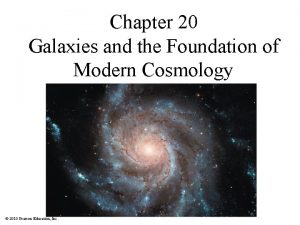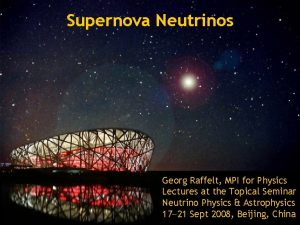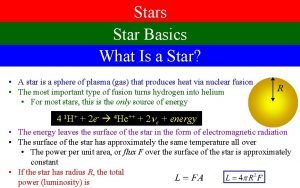Stars What are Stars A star is a










- Slides: 10


Stars What are Stars? • A star is a large ball of hot gas that emits huge amounts of energy. • The closest star to Earth is the Sun. It looks like a big star because it is so close to Earth, but there are many stars that are bigger and brighter than the Sun. • The Sun is 150 million km away from the Earth. • To compare large distances in the solar system, astronomers sometimes use a distance measurement called the astronomical unit (a. u. ), which is the average distance between the Earth and the Sun (1 a. u. = 150 million km)

Stars Units of Measurement in Space • The astronomical unit is useful in describing distances between objects in our solar system, but it is too small to describe interstellar distances. • Another unit called a light year is used to describe distances between stars. A light year is the distance that light travels in one year. Light travels at a speed of 300 000 km/s so in one year it can travel about 9. 5 trillion km (9 500 000 000 km)! • The closest star to us after the Sun is Alpha Centauri. It is 4. 3 light years away from us!

Stars • There are lots of different colours and sizes of stars. • The colours of stars tell us something about their temperature. • A relatively cool star glows red. • A very hot one glows bluish-white. • Star sizes vary from dwarfs to supergiants.

Stars • Stars can also be classified by their brightness. • About 2200 years ago, the Greek astronomer Hipparchus developed a system to classify stars based on their brightness. – The brightest stars were said to be first magnitude stars – The faintest stars were said to be sixth magnitude stars.

Stars Astronomers now use the word “magnitude”: in two ways: • Apparent magnitude refers to the brightness of the star as it appears to us from Earth. • Absolute magnitude refers to the actual amount of light given off by a star at a standard distance.

Stars • A group of stars that forms a pattern is called a constellation. • Many constellations represent characters from Greek mythology

Stars EXAMPLE • In Greek mythology, Orion was a great hunter, who was mistakenly killed by his wife. She placed him in the sky.

Stars • During a night, constellations will rise in the East and set in the West. This is due to the rotation of Earth about its axis (which happens once every 24 hours). • During a year, some constellations can only be seen during certain seasons. This is because the Sun blocks our view of some stars. As the Earth revolves around the Sun (this trip takes 1 year), new stars become visible, and others get hidden on the other side of the Sun. • Some stars that are directly overhead can be seen during all seasons, and are never blocked by the Sun.

Stars • Three of the most common constellations that we can see in the Canadian sky all year are shown in this picture. • Polaris



















